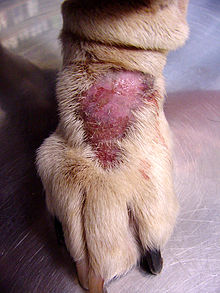Wound licking

Wound licking is an instinctive response in humans and many other animals to cover an
Mechanism

In animals


It has been long observed that the licking of their wounds by dogs might be beneficial. Indeed, a dog's saliva is
Risks
Wound licking is beneficial but too much licking can be harmful. An
In humans
Religion and legend
There are many legends involving healing wounds by licking them or applying saliva. Saint
In the Hebrew Bible saliva is associated with uncleanliness. However, in the Gospels, there are three different incidents in which Jesus uses saliva to cure (Mark 7:33, Mark 8:23, John 9:6). Köstenberger suggests "by using saliva to cure a man, Jesus claims to possess unusual spiritual authority."[44]
Risks
There are potential health hazards in wound licking due to infection risk, especially in
Licking of people's wounds by animals
History and legend
Dog saliva has been said by many cultures to have curative powers in people.
Modern cases
There are contemporary reports of the healing properties of dog saliva. Fijian fishermen are reported to allow dogs to lick their wounds to promote healing,[14] and a case of dog saliva promoting wound healing was reported in the Lancet medical journal.[53]
Risks
As with the licking of wounds by people, wound licking by animals carries a risk of infection. Allowing pet cats to lick open wounds can cause
- Dog
- A diabetic man who was infected by Pasteurella dagmatis due to the licking of his injured toe by his dog, causing a spinal infection.[62]
- A woman recovering from knee surgery suffered a persistent infection of the knee with Pasteurella after her dog licked a small wound on her toe.[63][64]
- A dog lick to an Australian woman's minor burn caused sepsis and necrosis due to Capnocytophaga canimorsus infection, resulting in the loss of all her toes, fingers and a leg.[65][66]
- C. canimorsus caused acute kidney failure due to sepsis in a man whose open hand wound was licked by his dog.[67]
- A 68-year-old man died from sepsis and necrotizing fasciitis after a wound was licked by his dog.[68]
- A patient with a perforated eardrum developed meningitis after his dog passed on a Pasteurella multocida infection by licking his ear.[69]
- Cat
- A woman recovering from surgery for endometrial cancer suffered from Pasteurella multocida infection causing an abscess after her cat licked the incision.[70]
- A blood donor whose cat licked her chapped fingers passed on Pasteurella infection to a 74-year-old transfusion recipient.[71]
- A seven-week-old boy contracted meningitis due to Pasteurella from contact with pet saliva.[72]
Idiomatic use
To "lick your wounds" means to "withdraw temporarily while recovering from a defeat"[73]
The phrase was spoken by
They look on us at distance, and, like curs
Scaped from the lion's paws, they bay far off
And lick their wounds, and faintly threaten war.
See also
- Cat scratch fever
- Folklore
- Maggot therapy
- Personal grooming
- Skin repair
- Vampire bat feeding
- Zoonosis
References
- S2CID 198383710.
- ISBN 9780618340682.
- S2CID 6281177.
- .
- PMID 21248061.
- PMID 21415275.
- PMID 16111647.
- S2CID 31895839.
- PMID 7548622.
- PMID 16700731. Archived from the originalon 8 January 2012.
- PMID 11114410.
- S2CID 7738015.
- ^ Kate Wong: A Protein's Healing Powers. Scientific American 2 October 2000
- ^ S2CID 5405352.
- S2CID 1540916.
- PMID 15302417.)
{{cite journal}}: CS1 maint: multiple names: authors list (link - S2CID 38787698. Archived from the originalon 5 January 2013.
- S2CID 57591440. Archived from the originalon 5 January 2013.
- PMID 10953025.
- PMID 15821102.
- PMID 3360895.
- S2CID 45969233.
- PMID 12454265.
- S2CID 13089523.
- PMID 12930131.
- PMID 6933491.
- )
- PMID 17305621. Archived from the originalon 10 October 2012.
- S2CID 19797007.
- ^ Wright K (28 December 2008). "Top 100 Stories of 2008 #62: Researchers Discover Why Wound-Licking Works". Discover Magazine.
- PMID 12759437.
- PMID 17101991.
- ^ Federation of American Societies for Experimental Biology. "Licking Your Wounds: Scientists Isolate Compound in Human Saliva That Speeds Wound Healing." ScienceDaily. ScienceDaily, 24 July 2008.
- S2CID 27717690.
- S2CID 21897174.
- S2CID 4273490.
- PMID 1685381.
- S2CID 25815676.
- PMID 18699812.
- PMID 16412222.
- ^ Fabrini P, Isoleri, Antonio (1900). The life of St. Mary Magdalen De-Pazzi : Florentine noble, sacred Carmelite virgin. Philadelphia.
{{cite book}}: CS1 maint: location missing publisher (link) - S2CID 170335886.
- ^ "Pliny Natural History: Book XXVIII: Chapter XXIII". Loeb Classical Library.
- ISBN 978-0-8010-2644-7.
- PMID 11973376.
- ISBN 9781576078747.
- ISBN 9781410209153.
- ^ The Aberdeen Bestiary, a thirteenth-century English illuminated manuscript
- S2CID 23136986.
- ISBN 9780521577793.
- ^ Ananikian M (1925). Armenian Mythology in The Mythology of All Races Volume VII. New York: Archaeological Institute of America, Marshall Jones Co.
- ISBN 978-1-60506-178-8. Archived from the originalon 25 July 2011. Retrieved 13 February 2009.
- PMID 4190562.
- PMID 15150182.
- PMID 7780401.
- PMID 11039085.
- S2CID 631013.
- PMID 7864502.
- PMID 15241303.
- PMID 10827733.
- PMID 9497502.
- PMID 16978746.
- S2CID 7446046.
- PMID 18566152.
- PMID 18566152.
- ^ Staff writers (25 July 2008). "Woman loses leg, fingers, toes from dog lick". Herald Sun. Retrieved 30 January 2009.
- PMID 11071985.
- S2CID 29739347.
- S2CID 34432193.
- PMID 12712125.
- S2CID 25123364. Archived from the originalon 5 January 2013.
- S2CID 24293826.
- ^ wikt:To lick one's wounds
- ^ Dryden J (1677). All for Love, or the World Well Lost. Archived from the original on 2 October 2015. Retrieved 27 March 2009.
